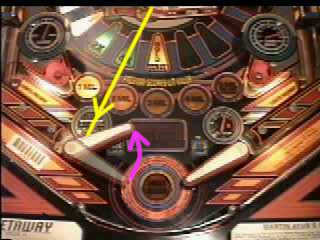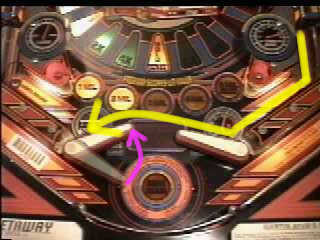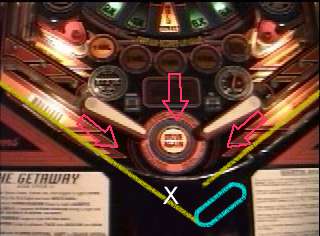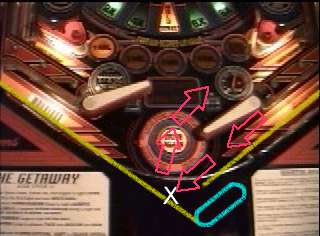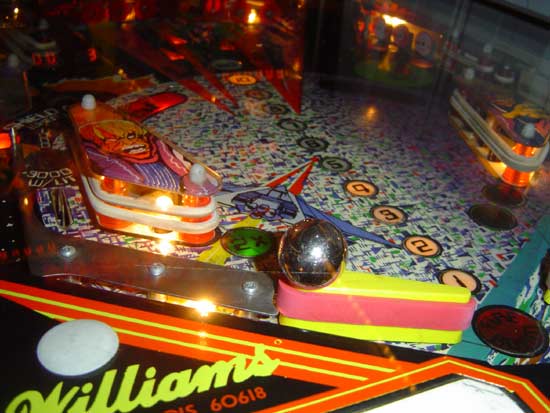|
|
|
SKILL
SHOTS
PART DEUX |
|
Hopefully you've read part one, tried out the moves, mastered them all and are now eager for more. No? Oh well, here we go anyway. We've looked at
catching and passing the ball and shown some of the techniques. With
all these moves, which one you use depends on these circumstances: Obviously you don't have much time to weigh-up these variables and choose your shot. It's a good idea to give yourself more time to decide by trapping the ball, having a think about it, making a pass if needed and then shooting away.
Dead Trap You can use the Drop Catch when the ball is heading straight at a flipper, but for those times when you need to think about the next shot, the Dead Trap is a good move.
The Dead Trap isn't an easy move to perform, but if you get it wrong through mistiming your flip it's unlikely to lead to a drain. Get it right and you're set up for either a considered shot or a pass.
Flipper Pass Not to be confused with the Post Pass, the Flipper Pass is an easy manoeuvre to make but provides plenty of scope to adjust it to the speed of the ball.
Alternatively, if the ball is moving fast enough, you can start with both flippers raised and when the ball hits the opposite flipper you can let it drop and perform a Drop Catch. But wait, there's more. If the ball is moving too fast for your liking, you can drop the first flipper just as the ball is rolling across it. This makes a kind of mini-Drop Catch - taking only some of the energy out of the ball. Finally, if the ball's not moving fast enough to cross the gap, you can drop the first flipper very slightly as the ball rolls across it, then raise it again to create a mini-flip. This pushes the ball slightly up the playfield increasing the length of the arc the ball makes.
Saving the ball So far we've been
talking about controlling the ball, but all good games must come to
an end and that's when the ball rolls either between the flippers or
down the left or right outlane, right? Well, not necessarily. Of those three ways to lose the ball, two are pretty much fatal, but one of them gives you hope of an eleventh hour reprieve. Your friend goes by the name of "right outlane". Look at how modern pinball games are constructed. The red arrows are the possible ways to lose the ball.
But when the ball drains down the right outlane, it strikes the left guide wall at point X and bounces slightly before falling into the outhole and it's here that you can try to reclaim it.
The Death Save To get a ball back from that position isn't easy and requires a reasonable amount of physical effort. You have to transfer enough energy from you, to the ball, to push it up the playfield and between the flippers. Basically, you're going to flip the ball. In order to do this, you need to make the gap between the flippers as large as possible. You achieve this by raising the left flipper. Then you have to push the whole game forward at the point where the ball hits point X. You also need to push slightly to the right in order to get past the flippers.
How well the manoeuvre works depends on several factors. Firstly, the ball needs to be travelling quite fast when it hits point X so it gets a little bit of bounce which helps you get the ball moving in the right direction. Secondly the game must be positioned such that you can push it forward and sideways. If it's hard up against a wall at the back or the right side then forget it. Ideally, the legs of the game should have a little "give" to them without being loose. That way you can probably avoid moving the legs on the floor. Timing is absolutely critical in this move. You have to push the game just very slightly before the ball hits point X. It's a hard trick to pull off, but once you'd worked it out it becomes much much easier. Give it a try, but only once you've seen the movie above, and remember to take it easy.
There is another manoeuvre of this type called a Bangback which involved slamming down and forward on the lockdown bar, but because it carries a severe risk of wrist and/or hand damage, it certainly can't be recommended and we won't be discussing it further in this article.
And so concludes part deux of our tutorial. There are several other techniques which players use and have developed to suit their own style of play. The key thing is that you feel comfortable in your style of play, as that leads to confidence and better game play. Hopefully you've picked up a few hints and tips in this article and can sprinkle them across your game. Play safely and try to emulate this ball trap technique!
© Pinball News 2001 |

